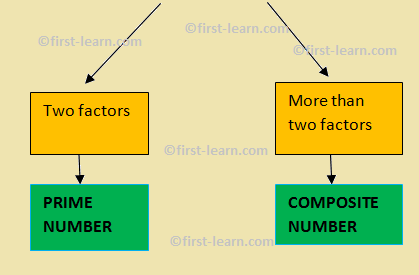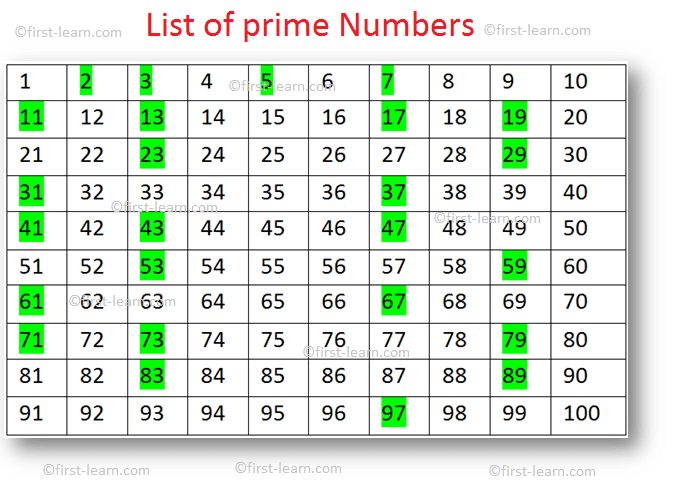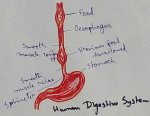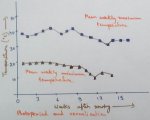Prime and Composite Numbers
Prime numbers are numbers that are divisible by one and itself or we can say that they have exactly two factors. These numbers only appear in the tables of 1 and the number itself. They do not appear in the table of other numbers.
Examples are: 2, 3, 5, 7, 11, and 13…… etc
Composite numbers are numbers that are not only divisible by one and itself but are divisible by other numbers as well or we can say they do not have exactly two factors but more number of factors. These numbers appear in the tables of various other numbers except one and the number itself.
Examples are: 4, 6, 8, 9, 12, 14, 16, and 18 ……….etc.
1 does not fall under the head of prime or composite number hence termed as co-prime number.
How can we find out whether a number is prime or composite?
Check the factors of the given number
There are two possibilities
Here is a list showing all the prime numbers
The numbers that are highlighted are prime numbers and the numbers that are not highlighted are called composite number.
1 is not highlighted but it is not a composite number it is a co-prime number as mentioned earlier.
One important thing to note from the grid of numbers given is that all the prime numbers are odd numbers except 2. That is why 2 is called the only even prime number as all other prime numbers are odd.
Examples of sum more prime numbers:
101, 103, 107, 109, 113, 127, 131, 137, 139, 149
Example:
Find the prime numbers from 50 to 60
|
Factors of 50 |
50 × 1 = 50 2 × 25 = 50 5 × 10 = 50 |
More than 2 factors; composite |
|
Factors of 51 |
51 × 1 = 51 3 × 17 = 51 |
More
than 2 factors; composite |
|
Factors of 52 |
52 × 1 = 52 26 × 2 = 52 13 × 4 = 52 |
More
than 2 factors; composite |
|
Factors of 53 |
53
× 1 = 53 |
2
factors; Prime |
|
Factors of 54 |
54 × 1=54 2 × 27 = 54 3 × 18 = 54 6 × 9 = 54 |
More
than 2 factors; composite |
|
Factors of 55 |
55 × 1 = 55 11 × 5 = 55 |
More
than 2 factors; composite |
|
Factors of 56 |
56 × 1 = 56 2 × 28 = 56 7 × 8 = 56 4 × 14 = 56 |
More
than 2 factors; composite |
|
Factors of 57 |
57 × 1 = 57 3 × 19 = 57 |
More
than 2 factors; composite |
|
Factors of 58 |
58 × 1 = 58 2 × 29 = 58 |
More than 2 factors; composite |
|
Factors of 59 |
59 × 1 = 59 |
2
factors ; Prime |
|
Factors of 60 |
60 × 1 = 60 6 × 10 = 60 2 × 30 = 60 3 × 20 = 60 4 × 15 = 60 12 × 5 = 60 |
More than 2 factors; composite |
From Various Types of Numbers to HOME PAGE
Recent Articles
-
Eleventh Grade | Eleventh Grade Science | Eleventh Grade Math
Jun 27, 25 12:26 AM
Eleventh grade biology has been designed in accordance with the recommended topics. We will cover all the topics in biology very exciting and interesting way. -
Explain Digestion of Food | Salivary Glands | Oesophagus | Stomach
Jun 27, 25 12:20 AM
Before the digestion is start by the different enzymes secreted from the different digestive glands food must be turned and chut or mixed with saliva inside the mouth. -
Explain Human Digestive System | Mouth | Tongue | Pharynx | Teeth
Jun 21, 25 01:15 PM
Digestive system is a system of alimentary canal and digestive glands. Alimentary canal- alimentary canal is a tube of variable diameter having muscular wall and glandular epithelial tissues which sta… -
Vernalisation in Plants | Definition | Mechanism | Devernalization |
Jun 18, 25 01:34 PM
Definition of vernalisation- The change of flowering habit due to the low temperature treatment is known as vernalisation. This is a physiological process which was denoted by Clipart in 1857 invite b… -
The Food We Eat | Food we Get from Plants and Animals | Carbohydrates
Jun 15, 25 03:20 PM
What are the food that we should eat? Find out the names of ten food items in the word maze. Write the names in the correct column of the table given below. Food we get from plants Food we get from an…






New! Comments
Have your say about what you just read! Leave me a comment in the box below.